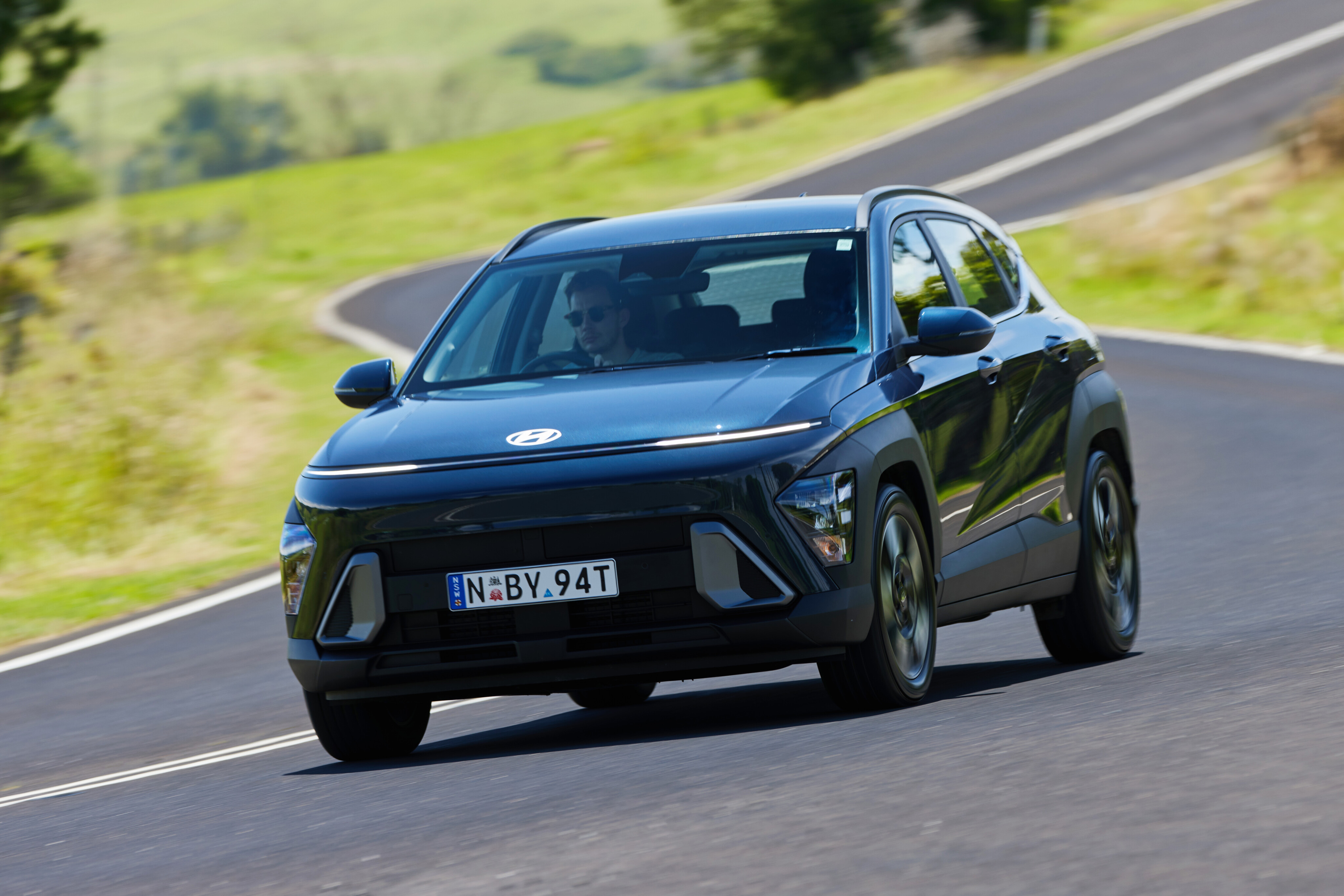
Score breakdown
Things we like
- Comprehensive feature list and tech suite
- Comfortable, spacious interior ideal for small families
- Good storage in cabin, decent boot space
- Good ride & comfort
Not so much
- Short on power, particularly in overtaking
- A lot of hard plastics in the cabin
- Boot space bettered by key rivals
- Enough safety-focused beeps and boops to drive you bonkers
Finally. The Kona Hybrid, detailed back in June, has now properly touched down in Australia. It stands to be an important addition to the new-generation range, and probably the most popular.
The Kona Hybrid is the second petrol-electric model in Hyundai’s current line-up, following the Santa Fe Hybrid while beating the upcoming i30 Sedan Hybrid and long-awaited Tucson Hybrid to market.
It also joins existing petrol-powered Kona models, and would have launched alongside the new Kona Electric – except that Hyundai Australia is still working out the pricing with its Korean masters.
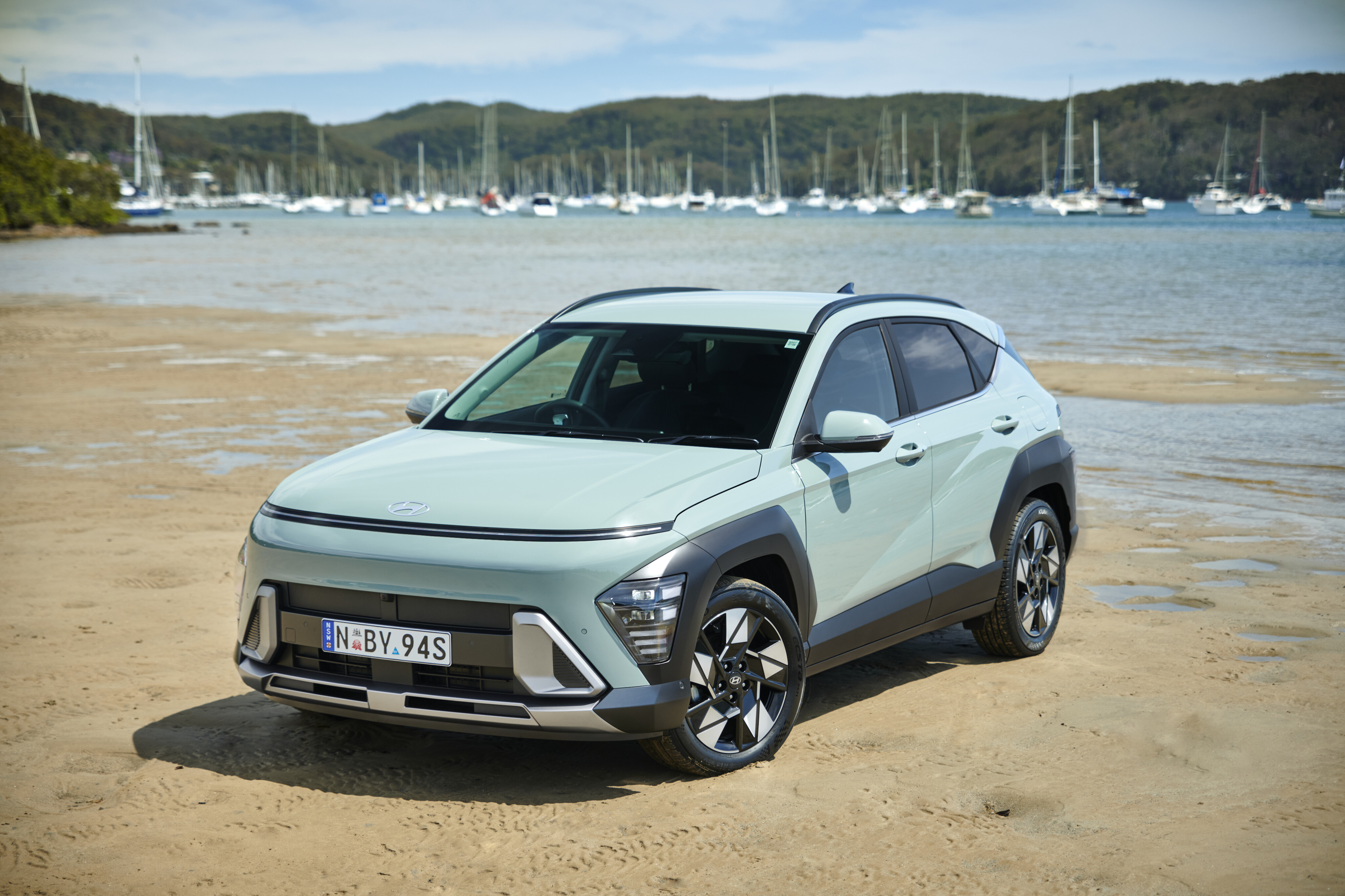
How much is it, and what do you get?
| Model | Pricing | Change (vs. 2023 Kona) |
|---|---|---|
| Kona Hybrid | $36,000 | new |
| Kona Hybrid N Line | $40,000 | new |
| Kona Premium Hybrid | $43,500 | new |
| Kona Premium Hybrid N Line | $46,500 | new |
| Prices exclude on-road costs | ||
Available in four trim grades, all front-wheel drive, the new Kona Hybrid starts from $36,000 – marking a $4000 premium over the petrol model.
Keeping things simple, the Kona Hybrid’s trim grades and equipment list mirror the petrol models, meaning what you got with the regular model’s launch in June, you also get here with the Hybrid.
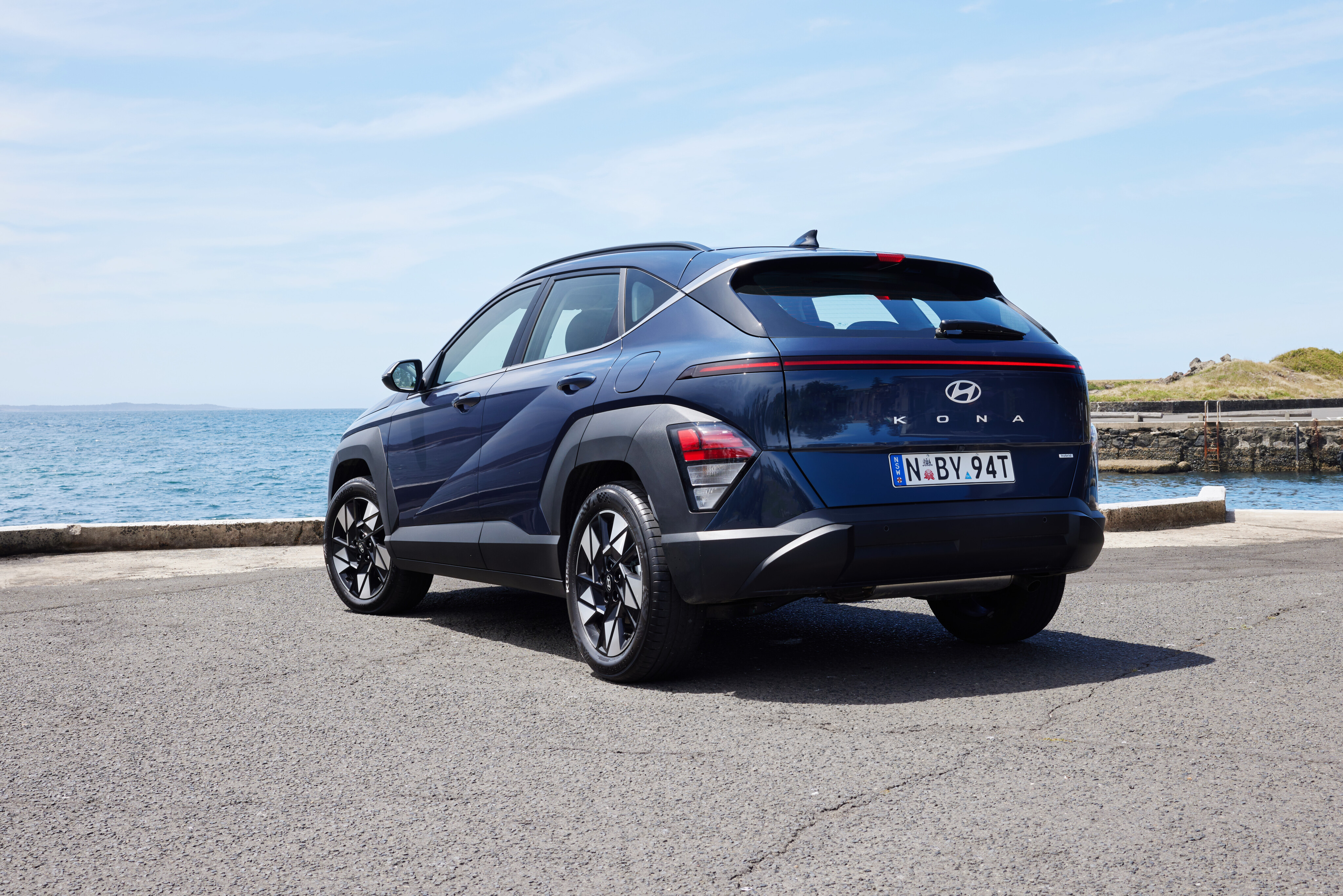
What's good?
Highlights across the petrol and hybrid range include 18-inch alloy wheels, a 12.3-inch main display, Hyundai’s Bluelink remote connectivity service with over-the-air (OTA) updates, plus dual-zone climate control, heated and auto-folding side mirrors, LED daytime lighting at both ends, a 15W wireless phone charger and wireless Apple Carplay and Android.
The Kona Hybrid builds on that with regenerative braking and torque-vectoring control, a column-mounted gear selector and the massive open cup-holder that move enables.
Kona petrol models, for reference
| Model | Pricing | Change (vs. 2023 Kona) |
|---|---|---|
| Kona | $32,000 | up $5100 (over base) |
| Kona N Line | $36,000 | new |
| Kona Premium | $39,500 | up $1200 (over Highlander) |
| Kona N Line AWD | $40,000 | up $2900 (over N Line AWD) |
| Kona Premium N Line | $42,500 | new |
| Kona Premium N Line AWD | $46,500 | up $3300 (over N Line Premium AWD) |
| Prices exclude on-road costs | ||
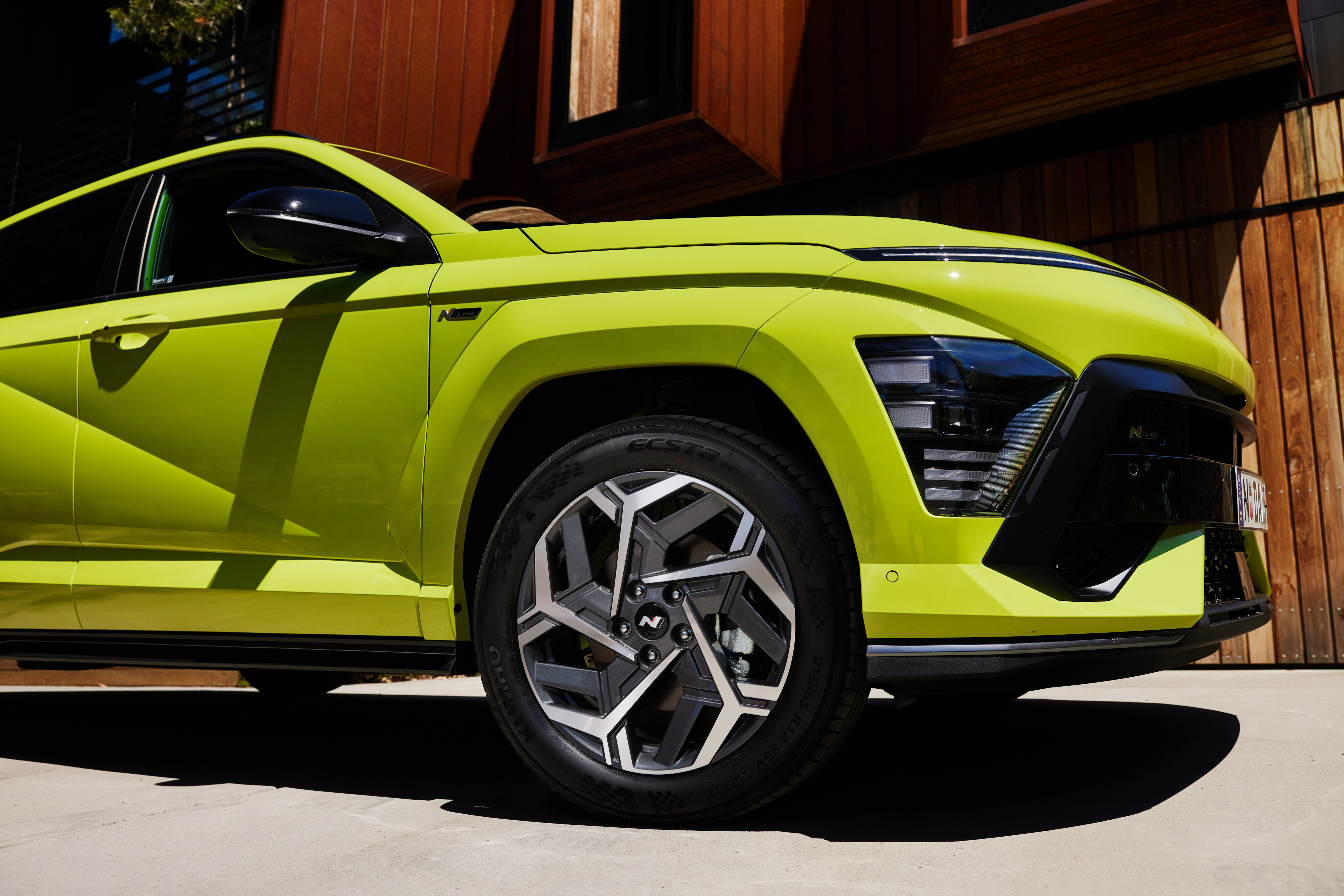
Features: Petrol & Hybrid alike
| 2024 Hyundai Kona features | |
|---|---|
| 18-inch alloy wheels | Keyless entry and push-button start |
| 12.3-inch display | LED headlights (reflector-type), tail-lights and DRLs |
| 4.2-inch semi-digital instrument cluster | LED cabin lighting |
| Wireless Apple CarPlay and Android Auto | Dual-zone climate control with rear vents |
| Hyundai Bluelink connected-car service | Rear-centre fold-down armrest |
| Over-the-air remote software updates | Remote start |
| DAB+ digital radio | Heated, auto-folding side mirrors |
| Six-speaker audio system | Front and rear parking sensors |
| 27W USB-C charge ports (3x front, 2x rear) | Manual height-adjustable driver’s seat with two-position power lumbar support |
| 15-watt wireless phone charger | Manual height-adjustable passenger seat |
| Black cloth upholstery | Tyre pressure monitoring |
| Leather-wrapped steering wheel and gear shifter | Roof rails |
The hybrid's shift-by-wire system means it's a little different inside
| 2024 Hyundai Kona Hybrid specific features | |
|---|---|
| Virtual engine sound system | Column-mounted shift-by-wire gear selector |
| Adjustable regenerative braking (to a complete stop) | Paddle shifters |
| Torque vectoring control | Open-type centre console |
| Low-speed audible pedestrian alert | Driver-only fan function |
| 2024 Hyundai Kona Premium adds | |
|---|---|
| 12.3-inch driver display | Eight-way power-adjustable passenger seat |
| Wired Apple CarPlay and Android Auto | Remote smart parking |
| Connected satellite navigation | Zero-gravity position relaxation seat function |
| Built-in voice recognition | LED headlights (projector-type) |
| Eight-speaker Bose audio system | LED turn signals and full-width front strip |
| Blind-spot view monitor | Rain-sensing wipers |
| 360-degree camera system | 64-colour ambient interior lighting |
| Reverse auto emergency braking | Side parking sensors |
| Hands-free electric tailgate | Acoustic laminated windshield |
| Black leather upholstery | Silver-plated skid plates |
| Heated and ventilated front seats | Rear privacy glass |
| Heated outer-rear seats | Auto-dimming rear-view mirror |
| Heated steering wheel | Dark grey body cladding |
| 10-way power-adjustable driver’s seat | Auto-tilting side mirrors in reverse |
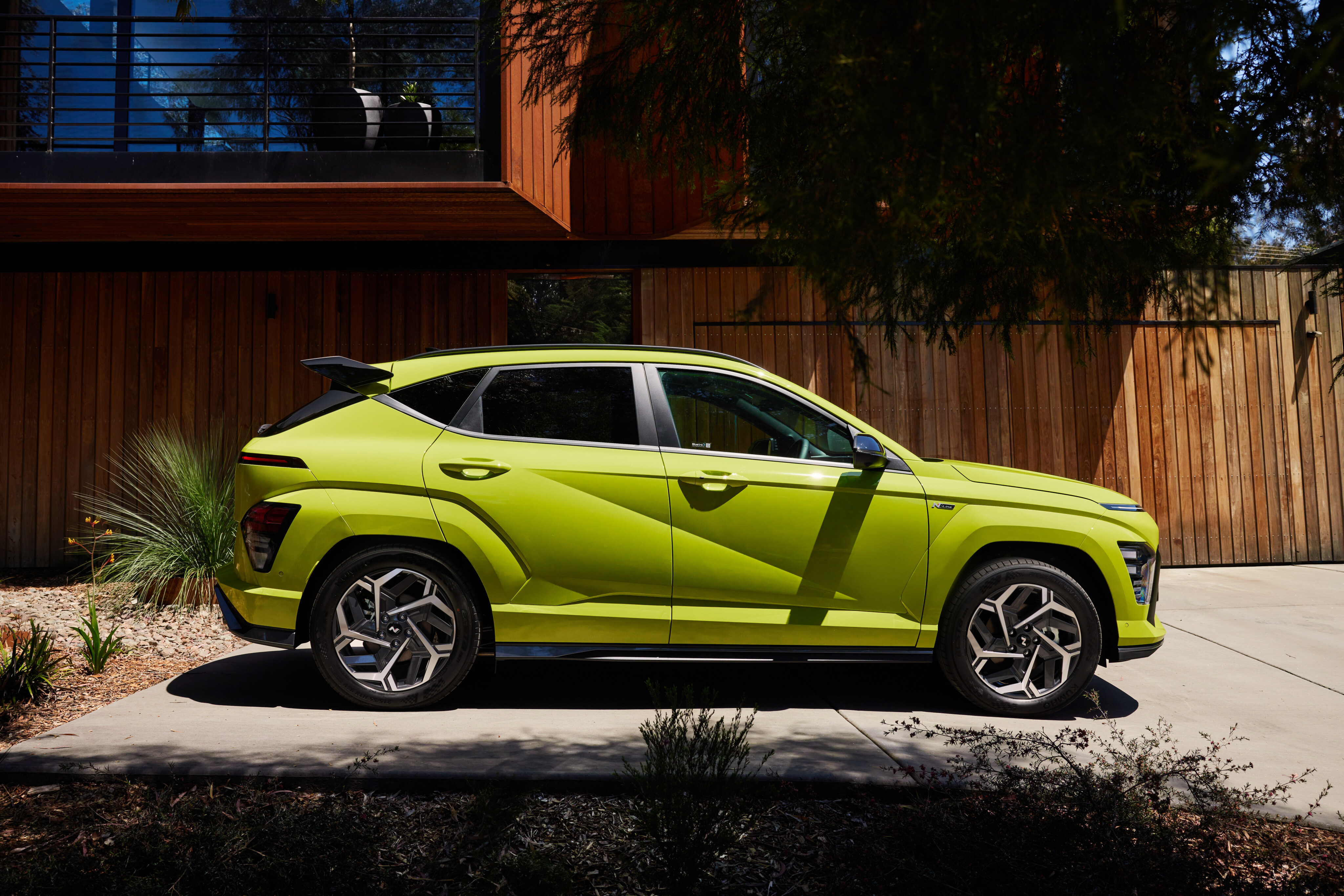
The N Line pack adds a number of sports-styled features, available on all petrol and petrol-electric hybrid models
| 2024 Hyundai Kona N Line kit | |||
|---|---|---|---|
| EXTERIOR | INTERIOR | FEATURES / TECH | |
| Bumpers/skid plates/side skirts | Leather appointed/Alcantara® interior | LED dual projector beam headlights | |
| Wing-type gloss black rear spoiler | Steering wheel w/perforated grips | LED ‘Seamless Horizon’ front | |
| Badges / N wheel centre caps | Active Red air vent/seat highlights | parking light | |
| 19-inch alloy wheels, 235/45 tyres | Dark Metal interior trim highlights | LED front/rear turn signals | |
| Chrome twin tip exhaust | Black headlining | 12.3-inch full digital instrument cluster | |
| Black mirror caps/beltline garnish | Alloy pedals | Electro-chromatic interior mirror | |
| Body coloured cladding | Sport scuff plates | Rain sensing wipers | |
| Specific for 1.6 GDi Hybrid: | Additional for 2.0 MPi: | *NOTE: above convenience features already std. on KONA Premium trim | |
| 18-inch N Line alloy wheels | Shift By Wire/paddle shift/open console | ||
Hyundai’s SmartSense safety suite is also featured in both trim grades, detailed further down in the safety section of this story.
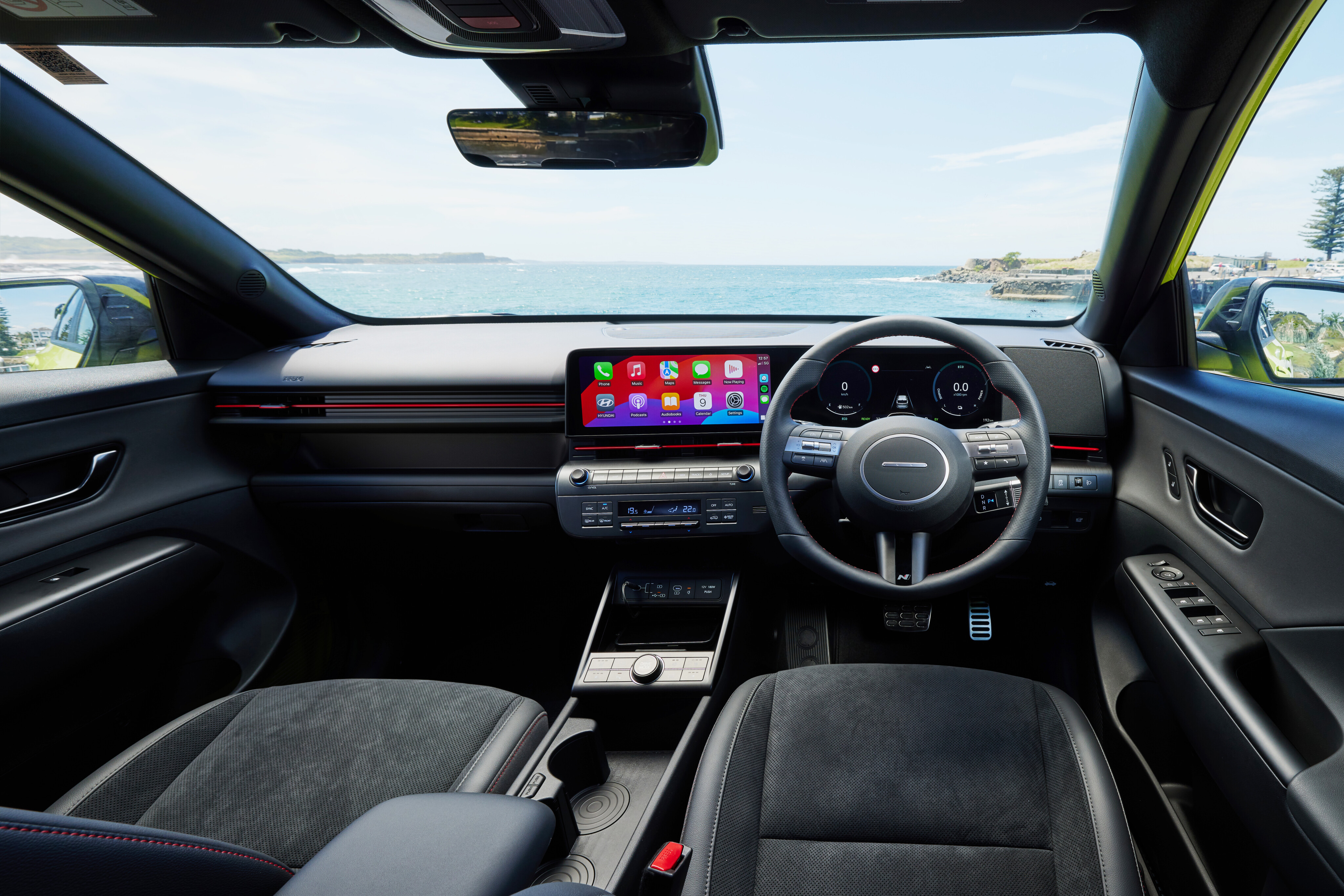
Interior quality, comfort, space and storage
Despite lacking in soft-touch surfaces, the new Kona's cabin is a stylish and thoughtfully arranged space.
Stepping into the new Kona, you’re greeted with a modern and sensible design. The bright, fast and huge 12.3-inch main screen is matched to a steering wheel and dash featuring a familiar range of critical function and convenience controls – something of a rarity in this age of all-screen cabins.
Spring for the Premium model and you get a second 12.3-inch display behind the steering wheel, where the base model gets retro-futuristic ‘digital analog’ gauges and a 4.2-inch screen.
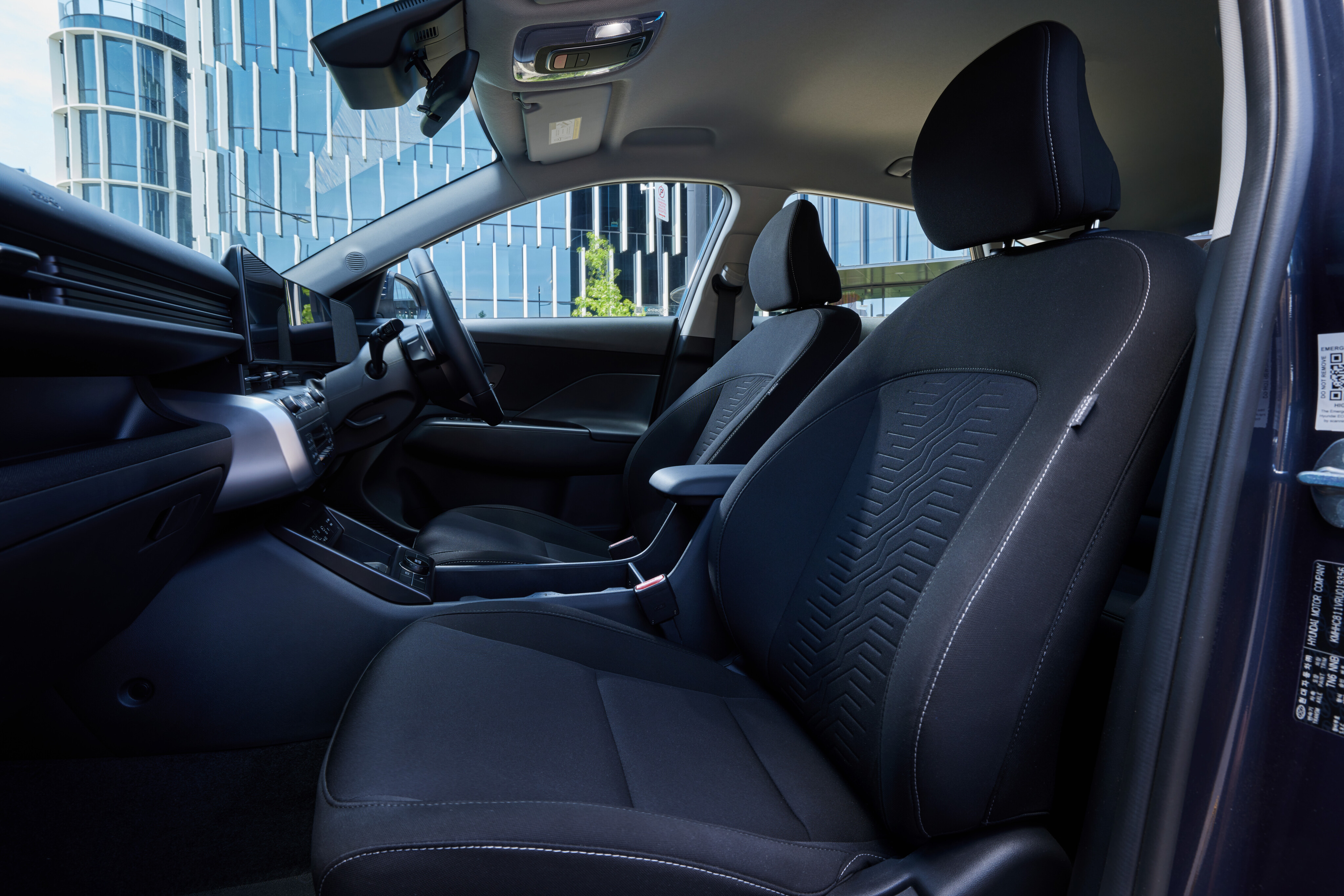
Unlike the first Kona, this new model is properly practical small SUV, its longer wheelbase well-suited to carrying a family of four in better than reasonable comfort.
The new Kona shares its platform with the i30 Sedan and Kia Niro, but its dimensions differ somewhat, with a wheelbase of 2660 millimetres – 60mm longer than before, but still 60mm shorter than the related vehicles.
Overall length grows by 150mm to 4355mm, and width is up 25mm to a new 1825mm. Hyundai says this results in a second row that offers 77mm more legroom and 11mm greater headroom, making it a segment leader in these dimensions.
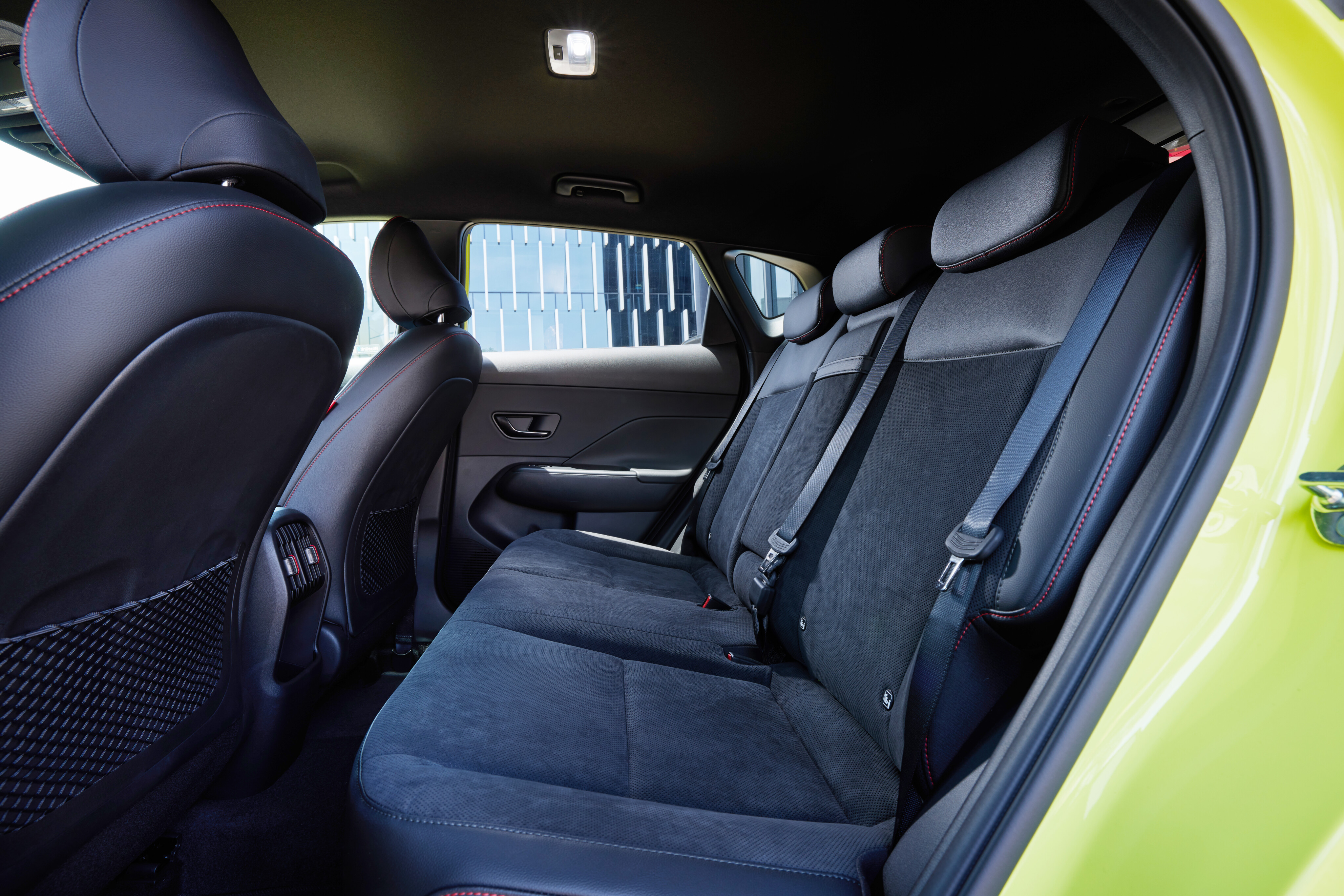
Comfort in both rows is good, with firm but supportive seats, cloth-trimmed in the entry model and ‘leather’-upholstered in the Kona Premium
For context, the popular Toyota Corolla Cross rides on a 2640mm (-20mm) wheelbase and measures 4460mm in overall length (+105mm), with an identical 1825mm width.
Comfort in both rows is good, with firm but supportive seats, cloth-trimmed in the entry model and ‘leather’-upholstered in the Kona Premium. Occupants in the front get well-bolstered backrests, along with a laidback “zero-gravity weightless posture” Relaxation position in the Premium to rest as desired. (More of a ‘stuck at a public charger for an hour’ EV feature really.)
Owners of the entry hybrid miss out on powered seats, with that function exclusive to the Kona Premium. Not uncommon for base models, but this could’ve been an opportunity to wow buyers.
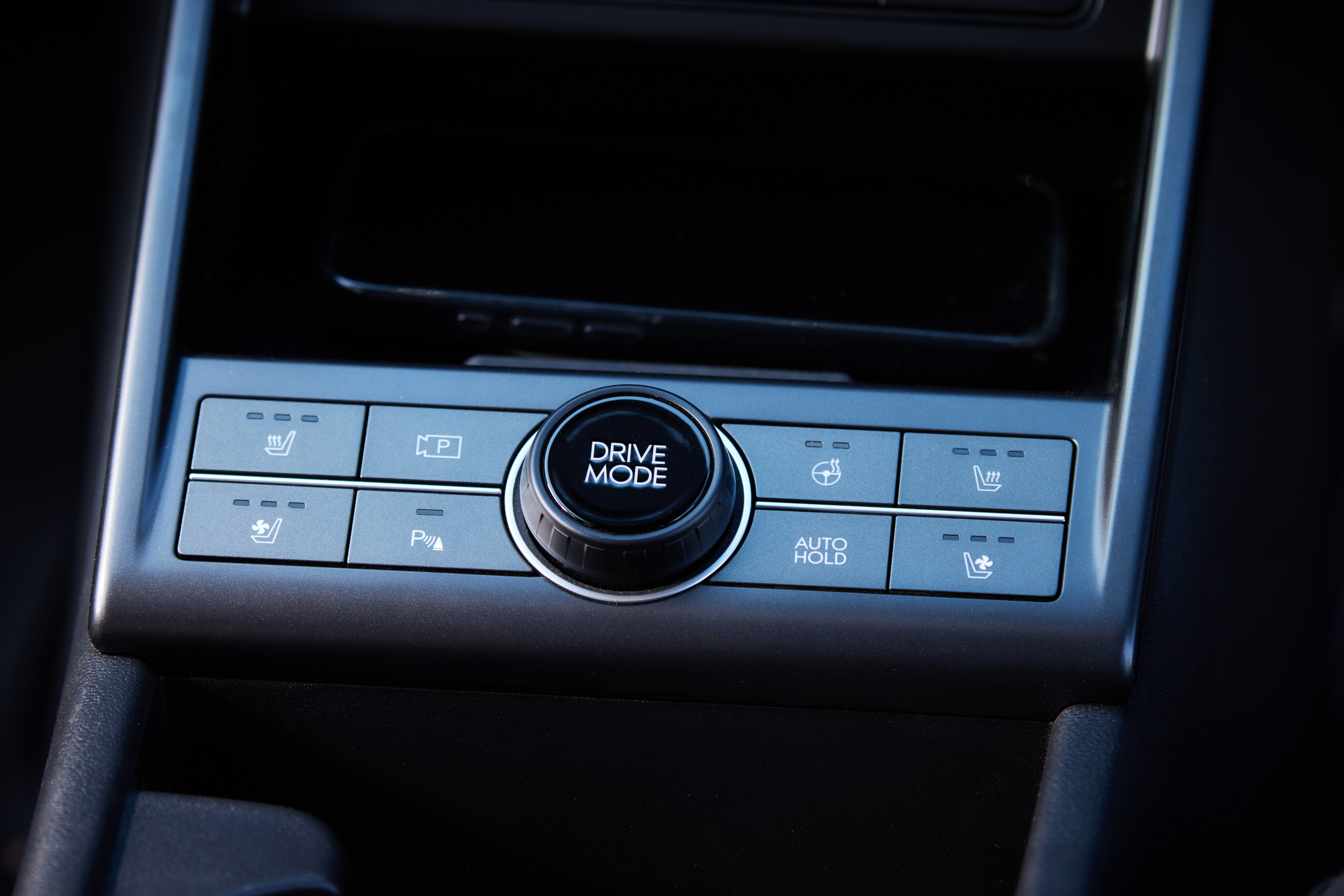
The new Kona’s longer wheelbase, along with scalloped front seatbacks and a flat rear bench, means adults in the second row have fairly generous leg and knee space.
Toe room under the front seats is likewise good, while the flat floor means any middle passenger will only be squashed from the hips up. Take your victories where you can get them… and the rear seats recline, too.
Storage in the Kona’s cabin is plentiful. The front row offers a cubby beneath the HVAC controls for 15W fast and cooled wireless phone charging or bits-and-pieces, while the cup-holder rings can be retracted to create a large open storage area – thanks in great part to the gear shifter moving to a column behind the steering wheel.
The centre console has no deep closed cubby, however, and lifting the armrest reveals only more open space.
There’s a long slim bench above the glove box, although its hard-plastic surface makes it fairly useless for storing anything while driving. The glovebox itself is deep, however, and the door bins are likewise large with plenty of space for a one-litre drink bottle and other items besides.
Occupants in the second row get a pair of small cup-holders in the fold-down centre arm rest, decent door bins and a map holder in the front seatbacks.
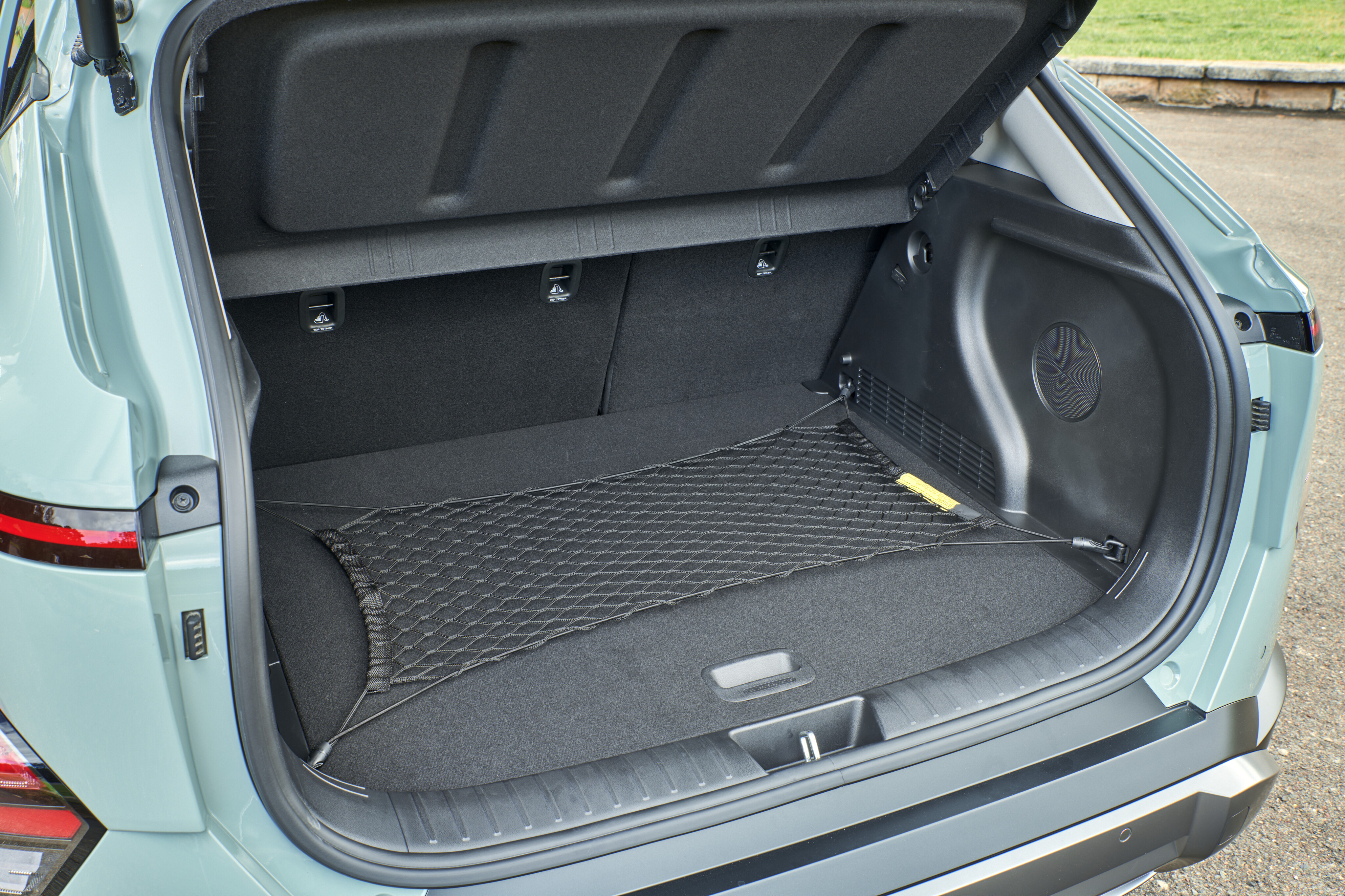
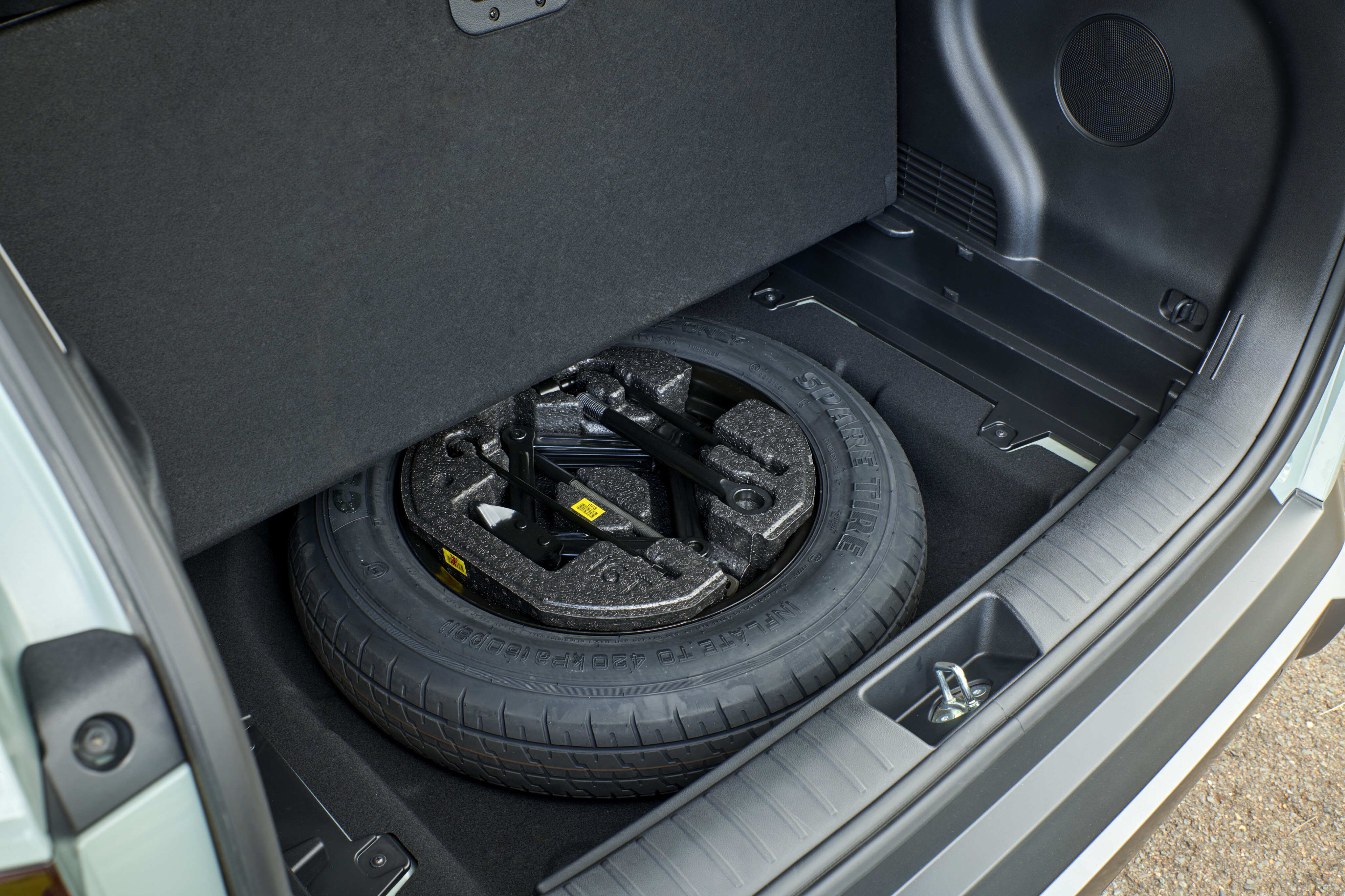
2024 Hyundai Kona Hybrid boot space
As with the petrol models, the new Kona Hybrid offers a decent 407 litres of boot space with the 60:40-split folding rear seats upright, expanding to 1241 litres when laid flat.
This area is a touch smaller than most rivals in the small-SUV segment, but Hyundai is eager to remind that its second-row legroom is best in class – so you can prioritise what matters to you most. Regardless, the new Kona's boot improves on the old model by 33 litres. Access to the boot is also made easier than before, thanks to a wider opening and a lower lip at the floor.
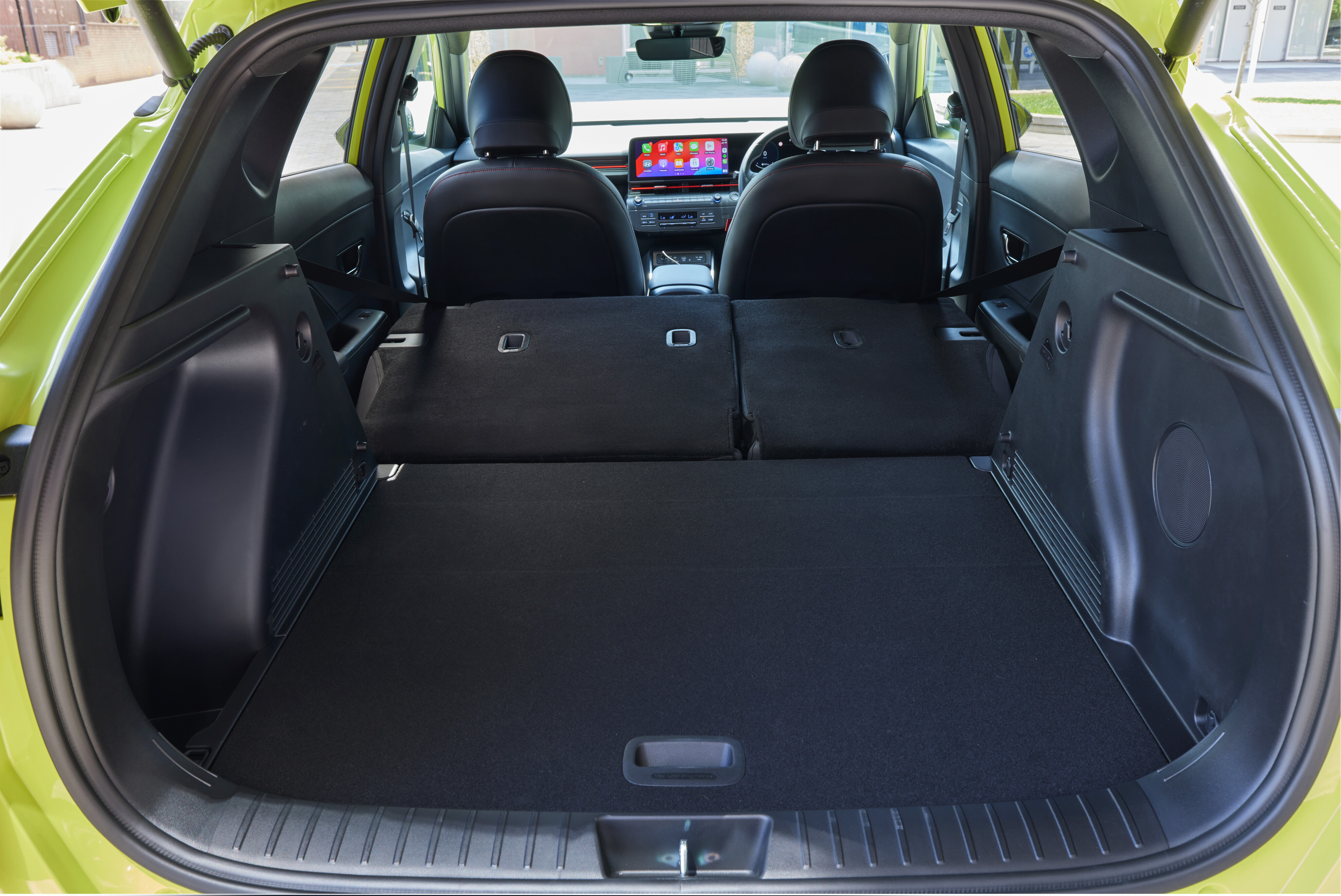
Mini matchup: Boot space
| MODEL | BOOT (litres) | WHEELBASE |
|---|---|---|
| Hyundai Kona (all) | 407 / 1241 | 2660mm |
| Kia Niro Hybrid | 425 / 1392 | 2720mm |
| Toyota Corolla Cross FWD | 414 / N/A | 2640mm |
| Kia Seltos | 433 / 1393 | 2630mm |
| Mazda CX-30 | 317 / N/A | 2655mm |
| Nissan Qashqai | 429 / 1425 | 2665mm |
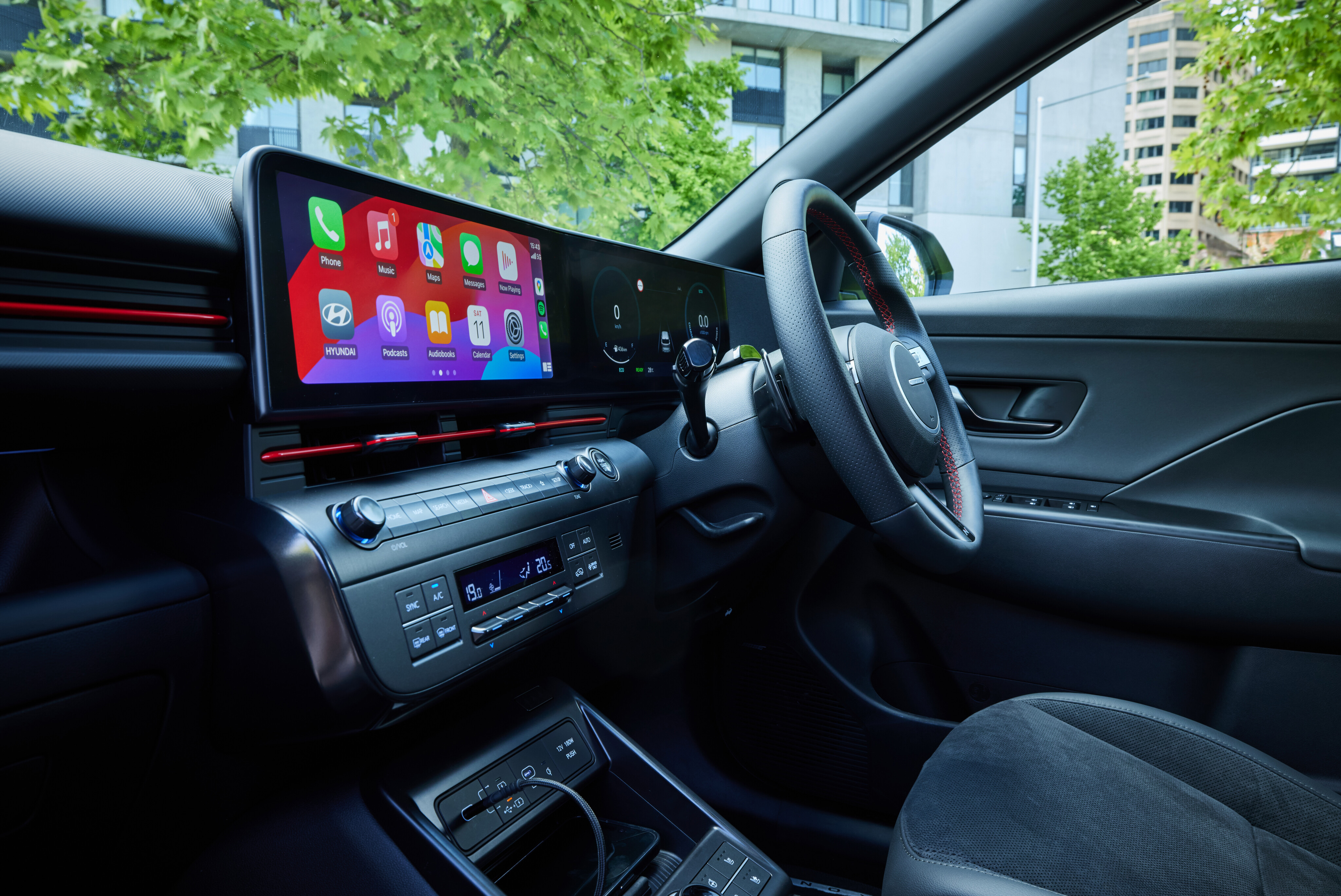
Technology in the cabin
Hyundai has come a long way with its in-car technology, packing an infotainment system now comfortably at the head of the class for feature richness, simplicity and power.
The new system boasts four times the computing power and 15 times the display processing power of Hyundai’s previous system, seen in the current Tucson and Santa Fe among others. The specifics of that are irrelevant to most users, except to say that touching and typing on the display feels like using a high-end Apple or Android tablet, with rapid responses to input and speedy transitions between pages.
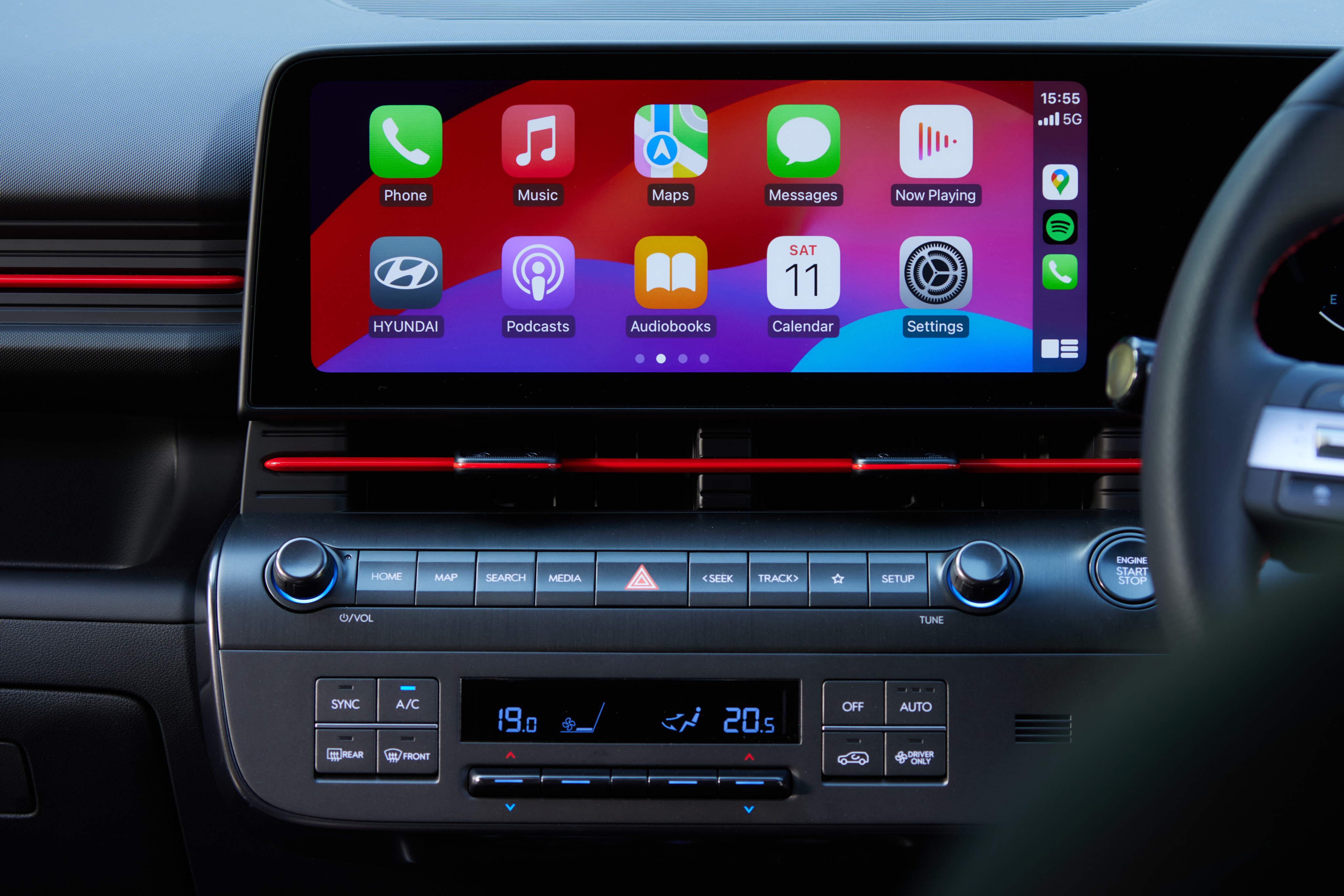
Controls for the Kona’s most frequently used features are almost all physical switches and dials, including the HVAC, media, cruise control and camera controls. Insert victory dance here.
Hyundai’s Bluelink connected services platform is also featured, allowing remote status monitoring and control of key features like door locks, windows, climate control, lights, horn, and trip planning. In this latest generation, Bluelink also enables over-the-air updates for safety, braking, performance, driver assist and mapping.
Both rows get fast 27W/3A rapid-charge USB-C charging ports. Apple Carplay and Android Auto are both featured and operate smoothly, but while wireless in the base model, in the Premium they remain a wired feature. Hyundai says it has a vehicle in Australia right now, testing with wireless connectivity, and hopes to roll out an OTA update in the coming weeks or months.
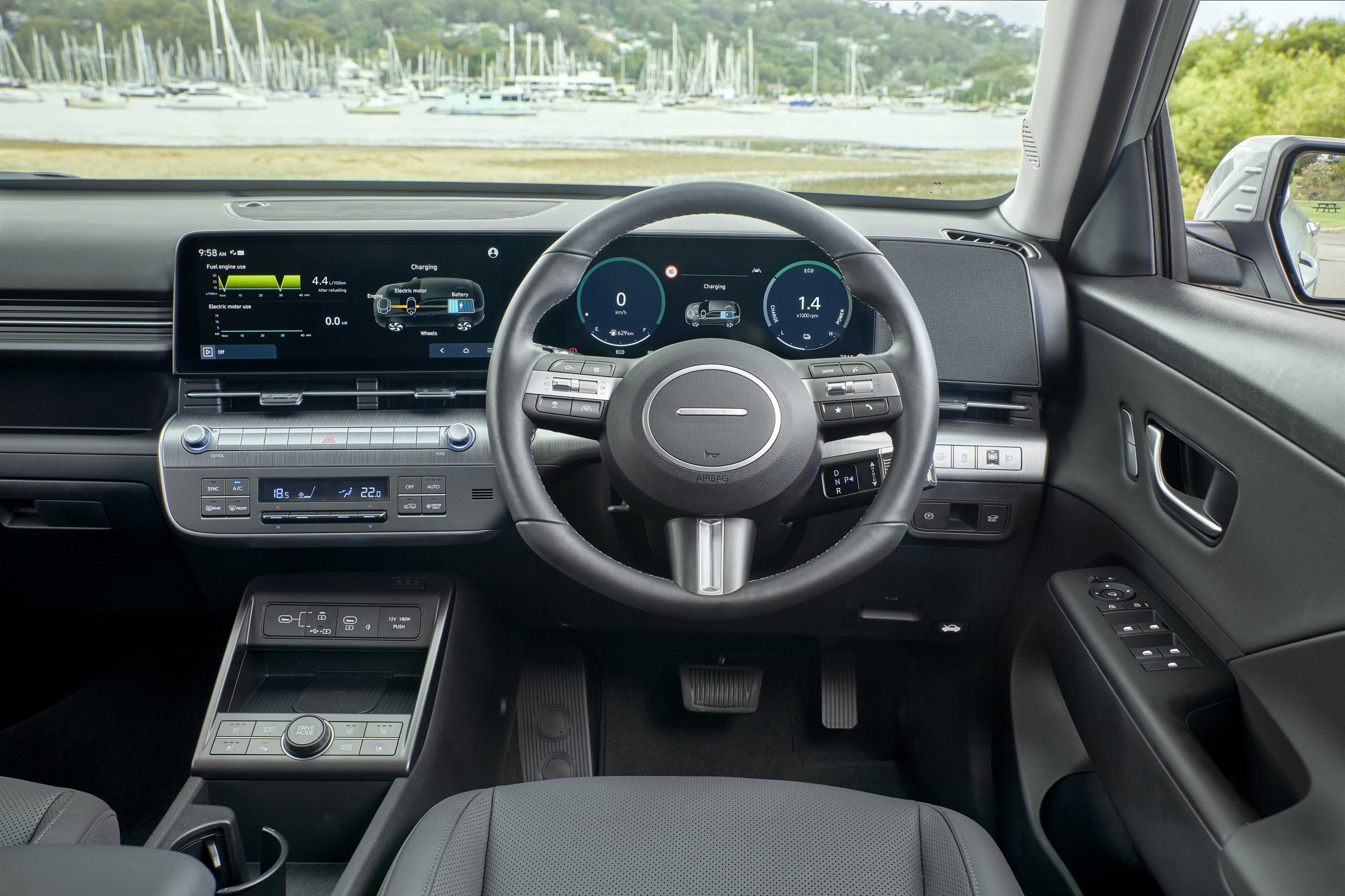
What is it like to drive?
The Kona Hybrid enters the range as the most fuel-efficient of the three petrol options, aimed squarely at Toyota’s popular Corolla Cross Hybrid.
Power comes from a familiar system in the Hyundai family, marrying a 77kW/104Nm 1.6-litre four-cylinder engine to a 32kW/170Nm electric motor between the engine and gearbox, for a combined 104kW and 265Nm.
Available only in front-wheel drive, the hybrid gets a six-speed dual-clutch automatic and multi-link independent rear suspension. This review is no twin-test comparison, but it’s worth noting the Corolla Cross keeps IRS for its more expensive AWD variants only, and each gets a CVT auto only.
Acceleration off the line and on the roll is responsive but also drops off quickly, ultimately having very little power to offer – so mind you’ve got a good long run-up if overtaking on country roads. Braking is strong, at least, and easily modulated with good top-of-pedal feel.
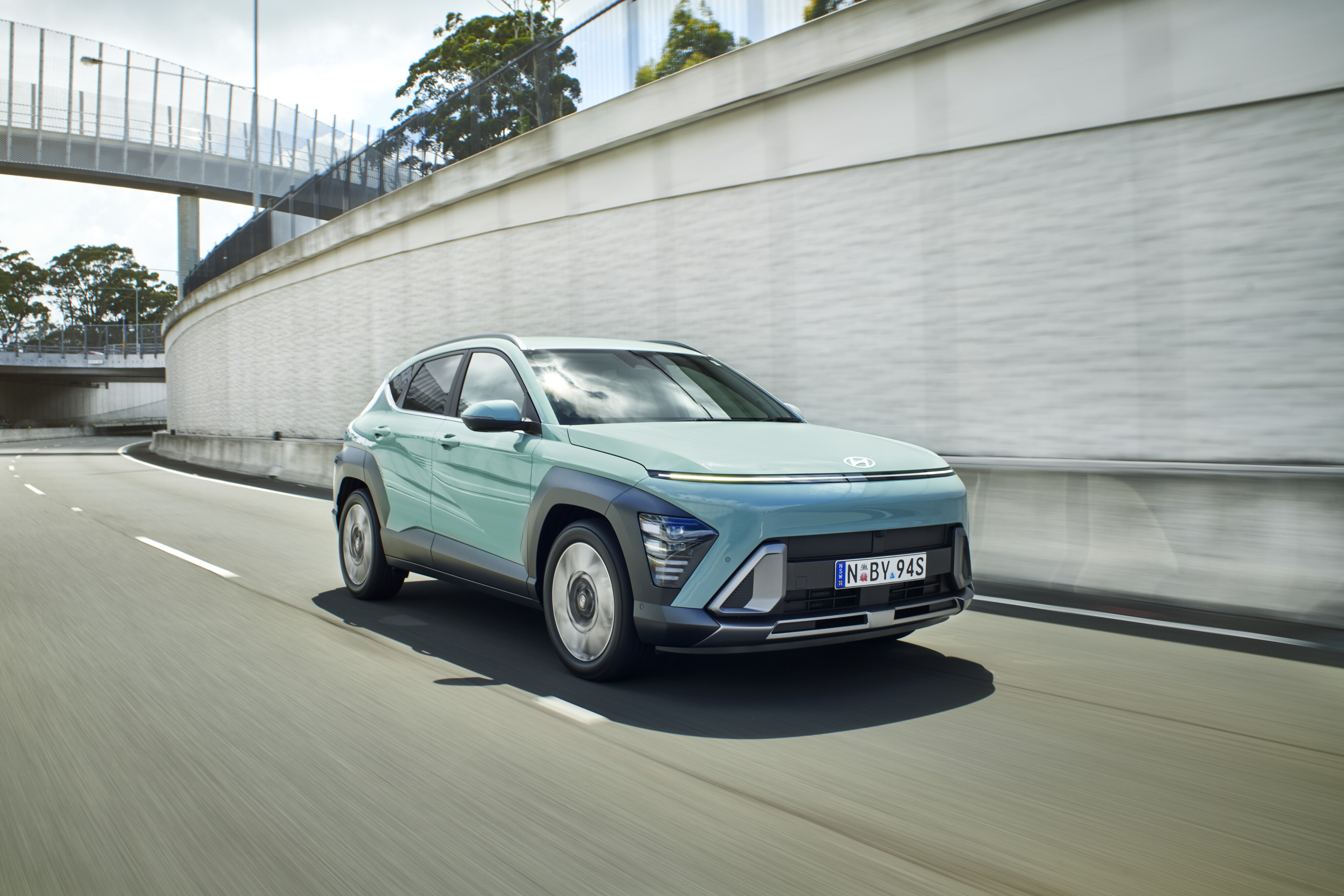
The petrol-electric relationship here is very neatly refined, with the electric motor capable of powering the Kona at highway speeds, while the petrol engine kicks in fairly seamlessly when needed and keeps the noise down as it’s running.
Hyundai’s scheduled drive route through regional Canberra took in plenty of winding roads, and while this wasn’t the Electric model’s ideal playground (can’t talk about that yet, embargoes and all), the Kona Hybrid was largely unfussed.
Hyundai doesn’t do a full local tuning program, but ride and comfort is nonetheless well refined, as it is with the regular petrol models – handling poor surfaces and undulations well enough to leave little cause for complaint of poor comfort, while firm enough to entertain more spirited drivers.
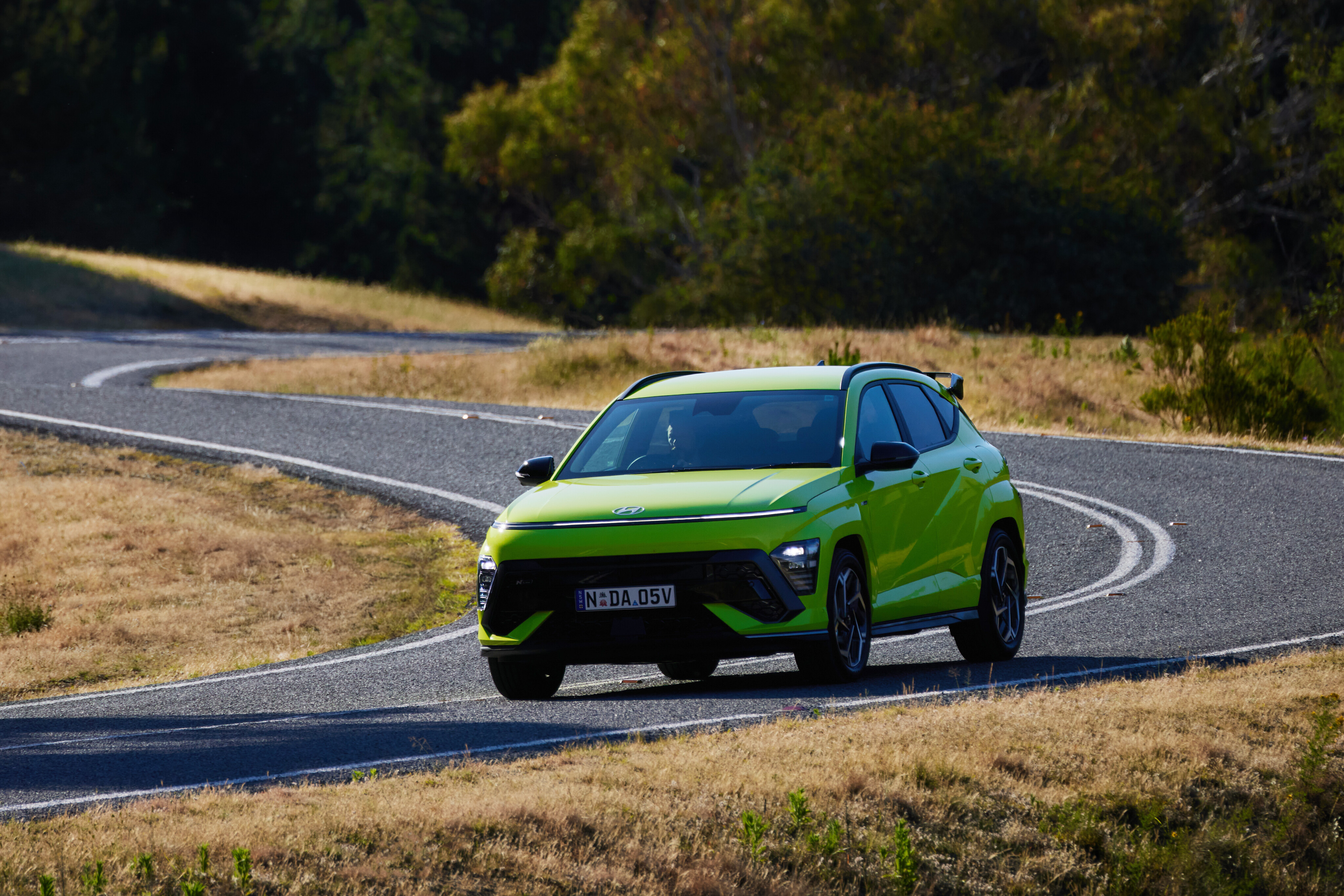
Steering is responsive and accurate in turns, with a good and confident straight-ahead feel on the highway. Enthusiasts will lament the lack of feedback, but this is increasingly common in newer cars, and not something most motorists will detect.
Of course, the Kona wasn’t designed to be driven in anger - even in style-focused N Line form – and with most buyers it never will be. Ride and comfort is overall good in the entry model, with its region-specific (but not Australian-tuned) suspension package and 18-inch wheels wrapped in thick-walled if narrow-bodied 215/55 rubber, helping it maintain composure across most surfaces.
The N Line’s 19-inch wheels and 235/45 tyres sacrifice some comfort for style points, but not by much – and it really does look the business in that sporty spec.
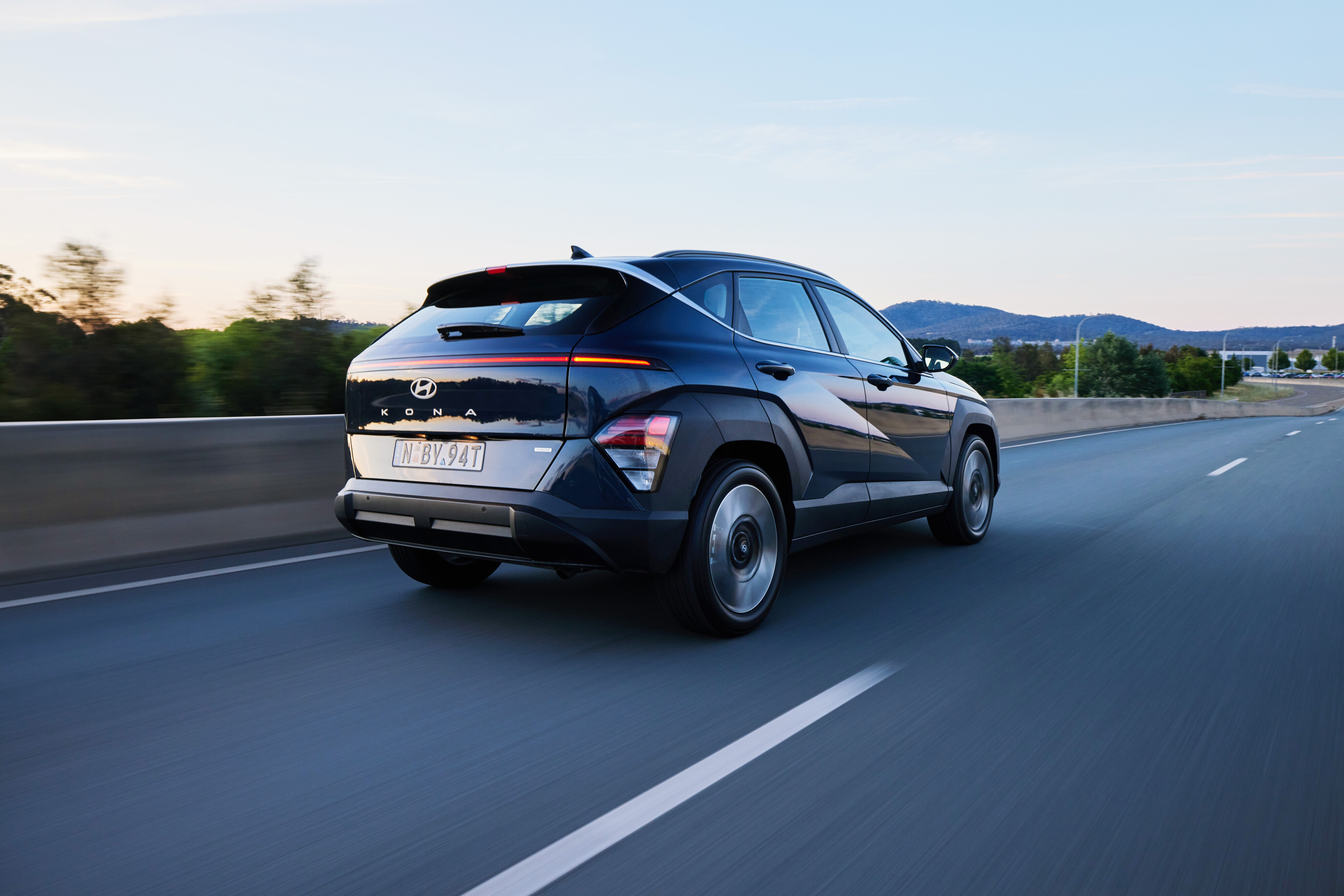
The Hybrid is also equipped with a full EV-style regenerative braking system, allowing you to slow your entry into corners without touching the brake pedal.
The system allows you to reduce reliance on the brake pedal while also feeding energy back into the battery.
Wind and road noise, a more prominent companion with the often 'combustionless' running in electrified vehicles, is well enough damped. Only a back-to-back test with the Corolla Cross Hybrid would say for certain, but upgrading to higher-quality tyres on your first replacement would only help.
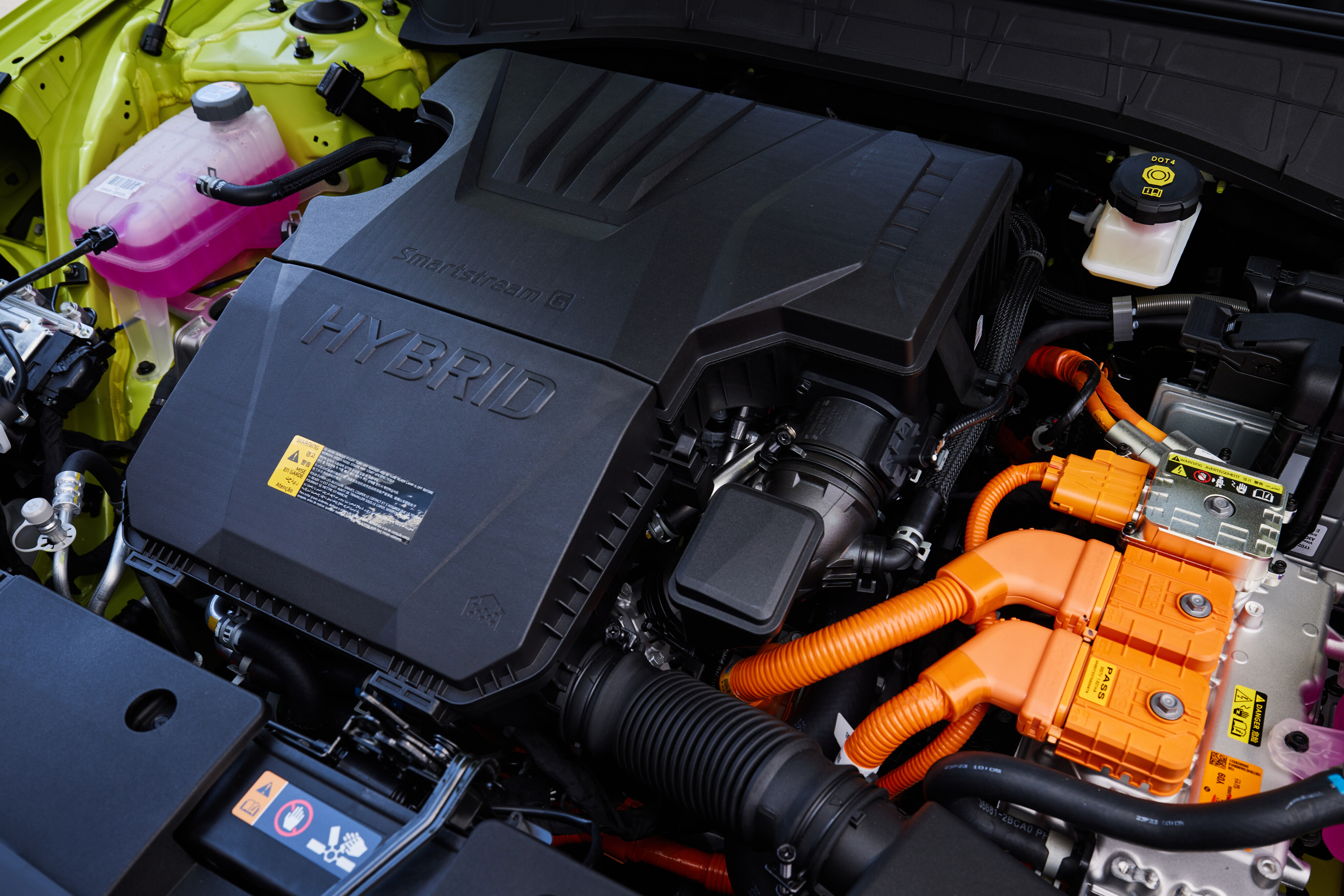
How is it on fuel?
Fuel consumption is listed at a low 3.9L/100km combined. Our long and varied drive loops on the day saw my shared car return an indicated 5.7L/100km, which I consider a solid result for a launch event.
In true daily driving, Hyundai’s claimed figure should be in reach, but we’ll be better able to assess that when we’ve had more time with the car.
Toyota’s Corolla Cross Hybrid lists a claim 4.3L/100km in front-wheel-drive form, while our week with the GX spec returned 4.8L/100km.
| 2024 Hyundai Kona fuel economy | |||
|---|---|---|---|
| 1.6-litre hybrid FWD | 3.9L/100km | 89g/km | new |
| 2.0-litre petrol FWD | 6.6L/100km | 149g/km | down 0.4L/100km |
| 2.0-litre petrol N Line FWD | 6.6L/100km | 154g/km | new |
| 1.6-litre turbo-petrol AWD | 7.6L/100km | 174g/km | down 0.7L/100km |
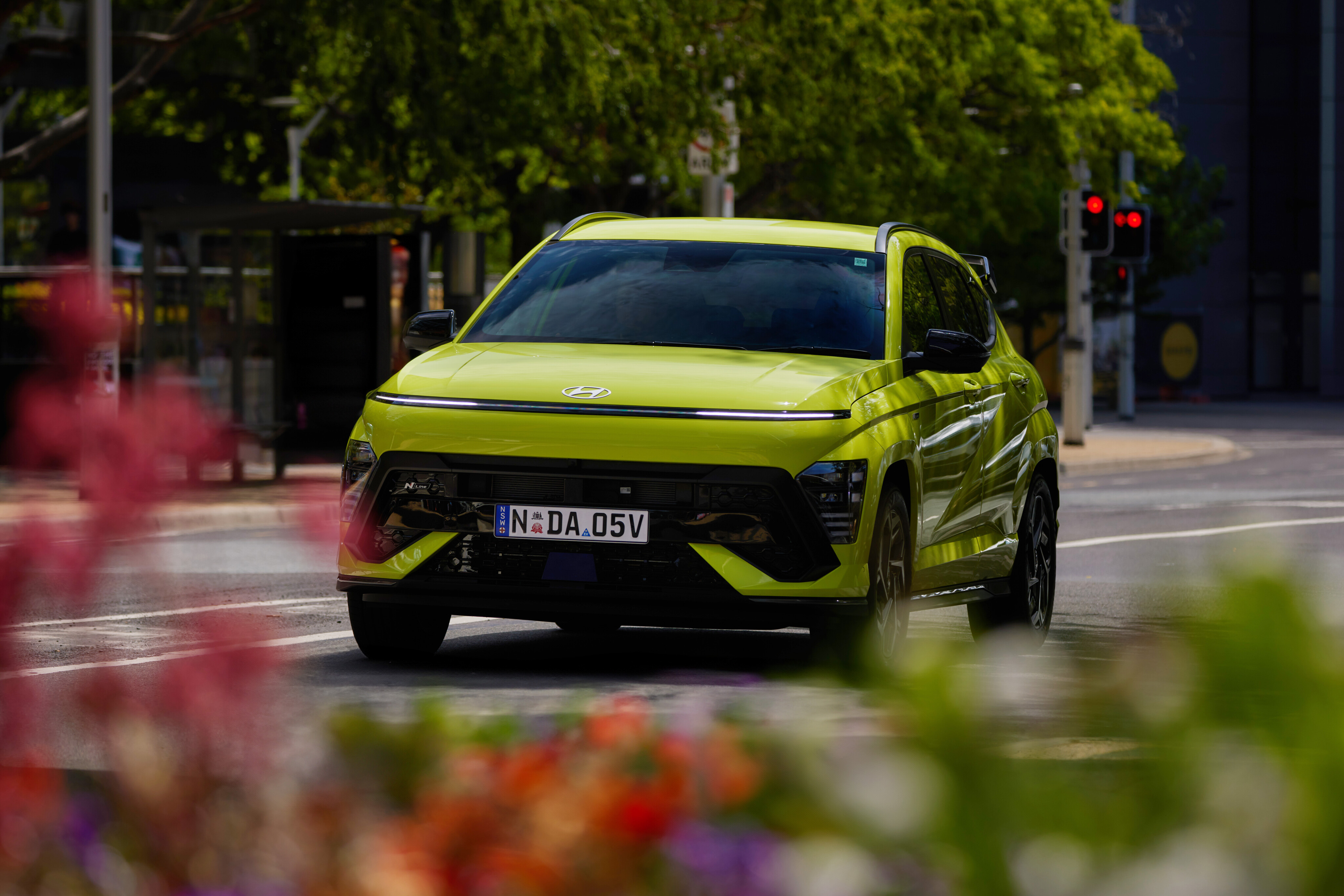
How safe is it?
The new Kona has not yet been awarded an ANCAP or Euro NCAP safety rating (expected in December), but it does come with strong credentials – featuring seven airbags including a front centre airbag, and a suite of advanced driver aids under the Hyundai SmartSense banner.
| 2024 Hyundai Kona active safety features | |
|---|---|
| Autonomous emergency braking (vehicle, pedestrian, cyclist, motorcycle, junction-turning, direct oncoming) | Traffic sign recognition |
| Lane-keep assist | Intelligent speed limit assist |
| Lane following assist | Driver attention alert |
| Blind-spot alert | Driver monitoring camera |
| Rear cross-traffic alert | Leading vehicle departure alert |
| High beam assist | Safe exit warning |
| Adaptive cruise control | Rear occupant alert. |
| 2024 Hyundai Kona Premium adds | |
|---|---|
| Blind-spot view monitor | 360-degree camera system |
| Low-speed reverse AEB | Remote smart parking assist. |
| Side parking sensors | |
As with all cars with these types of systems, properly assessing their capability requires a lot of closed-road conditions – but what I can tell you is that, for whatever the extent to which these systems can protect you, they’re bloody annoying in the meantime.
With all of its active safety systems running, this Hyundai throws more beeps and boops at you in one trip than R2-D2 does in all of Episode 4 – and I can’t help but wonder if driving people to madly disabling alerts isn’t undoing the benefits of their intended function.
To its credit, Hyundai’s commitment to safely accessed controls and visible displays is commendable. Where some brands – like Tesla and now Volvo with its small EX30 – aren’t bothering with a dedicated driver display or even a head-up to display, the Kona has not only its two huge 12.3-inch screens, but also a giant 12-inch head-up display. No chance of missing the speed limit or any visual alerts.
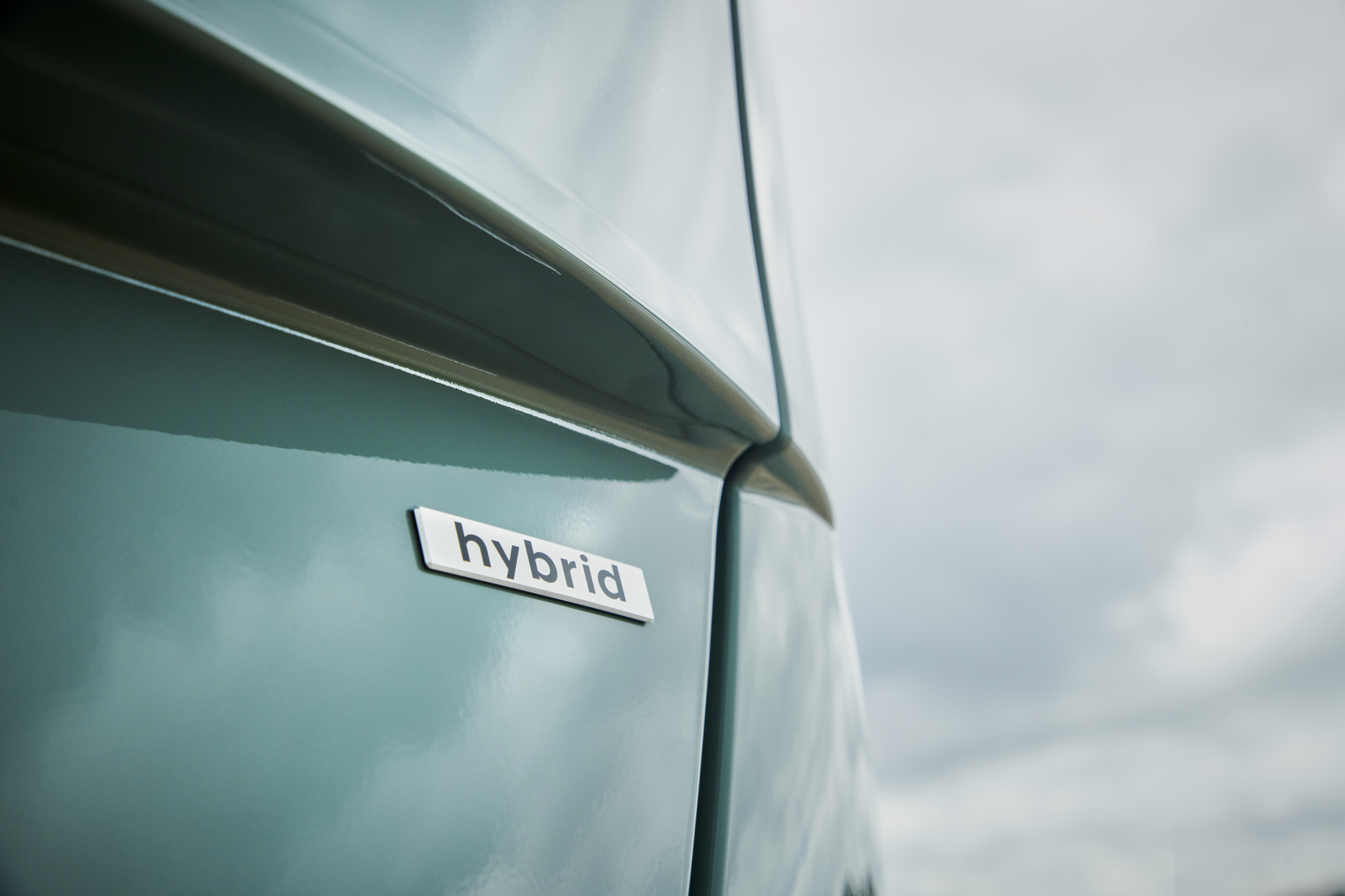
2024 Kona warranty and running costs
The new Kona is covered by Hyundai’s 5-year / unlimited-kilometre vehicle warranty.
These terms are now fairly standard for the Australian car market, with only a few offering less than unlimited kilometres, and again only a handful offering better than five years on the vehicle.
Services come around every 12 months/15,000km (10,000km for the 1.6L turbo) and, as always, the company offers a five-year capped price servicing regime as well as a lifetime projection of service costs.
The first five services cost $399 whether you go turbo or stick with the 2.0-litre in the base model, but the turbo’s services are due every 10,000km. It’s not especially cheap but lines up with just about everything apart from the Corolla Cross.
| 2024 Hyundai Kona Hybrid servicing costs | |||||
|---|---|---|---|---|---|
| Km | 15k | 30k | 45k | 60k | 75k |
| Cost (incl. GST) | $399 | $399 | $399 | $399 | $399 |
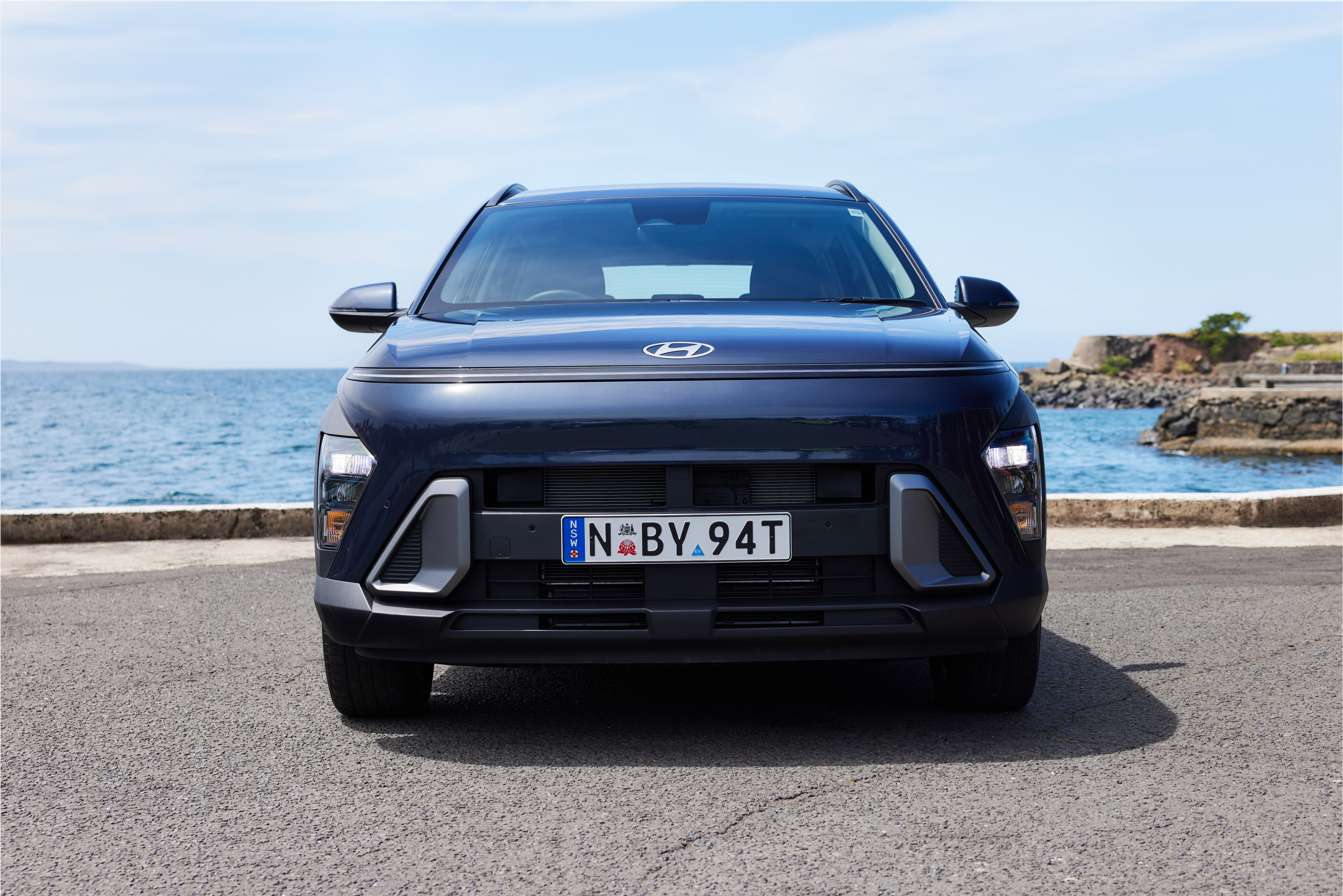
VERDICT
As with the previous Kona, which was a popular offering for much of its life, there’s a lot to like with this new generation – and even more so in new Hybrid form.
Competition is strong in the Corolla Cross, but while much of Toyota’s range is evolving with stylish and confident themes, the Kona has the edge in that regard.
Likewise, Toyota’s experience with hybrid technology is pioneering and industry leading, but Hyundai has learned fast and its own hybrid powertrains have impressed media and market alike. That continues here with the Kona.
The Kona Hybrid could do with a little more guts, but at this end of the class, it’s all about fuel efficiency – and when affordability is also in the picture, you can really only have one or the other.
You’ll pay more to get into the Hyundai than the Toyota, but the Kona Hybrid has come in with a strong base model specification – arriving as a rival to the Corolla Cross GXL rather than the entry GX, and is thus priced accordingly.
Both cars are worth a drive, and both have their strong suits, but the Kona Hybrid is at least worth its salt as a small and fuel-efficient SUV with space enough for a family of four and the safety suite to match. But bloody hell, those beeps and boops...
Score breakdown
Things we like
- Comprehensive feature list and tech suite
- Comfortable, spacious interior ideal for small families
- Good storage in cabin, decent boot space
- Good ride & comfort
Not so much
- Short on power, particularly in overtaking
- A lot of hard plastics in the cabin
- Boot space bettered by key rivals
- Enough safety-focused beeps and boops to drive you bonkers



COMMENTS